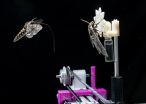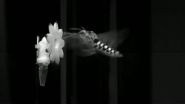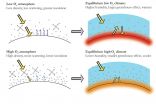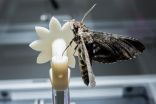(Press-News.org) It's difficult enough to see things in the dark, but what if you also had to hover in mid-air while tracking a flower moving in the wind? That's the challenge the hummingbird-sized hawkmoth (Manduca sexta) must overcome while feeding on the nectar of its favorite flowers.
Using high-speed infrared cameras and 3-D-printed robotic flowers, scientists have now learned how this insect juggles these complex sensing and control challenges - all while adjusting to changing light conditions. The work shows that the creatures can slow their brains to improve vision under low-light conditions - while continuing to perform demanding tasks.
What the researchers have discovered could help the next generation of small flying robots operate efficiently under a broad range of lighting conditions. The research, supported by the National Science Foundation and Air Force Office of Scientific Research, will be reported in the June 12 issue of the journal Science.
"There has been a lot of interest in understanding how animals deal with challenging sensing environments, especially when they are also doing difficult tasks like hovering in mid-air," said Simon Sponberg, an assistant professor in the School of Physics and School of Applied Physiology at the Georgia Institute of Technology. "This is also a very significant challenge for micro air vehicles."
Scientists already knew that the moths, which feed on flower nectar during the evening and at dusk and dawn, use specialized eye structures to maximize the amount of light they can capture. But they also surmised that the insects might be slowing their nervous systems to make the best use of this limited light. But if they were slowing their brains to see better, wouldn't that hurt their ability to hover and track the motion of flowers?
Sponberg and colleagues at the University of Washington studied this question using high-speed infrared cameras and nectar-dispensing robotic flowers that could be moved from side-to-side at different rates. While varying both the light conditions and the frequency at which the flowers moved, the researchers studied how well free-flying moths kept their tongues - known as proboscises - in the flowers.
They also measured real flowers blowing in the wind to determine the range of motion the insects had to contend with in the wild.
"We expected to see a trade-off with the moths doing significantly worse at tracking flowers in low light conditions," said Sponberg. "What we saw was that while the moths did slow down, that only made a difference if the flower was moving rapidly - faster than they actually move in nature."
In the experiments, the moths tracked robotic flowers that were oscillating at rates of up to 20 hertz - twenty oscillations per second. That was considerably faster than the two-hertz maximum rate observed in real flowers. Because the moth's wings beat at a rate of about 25 strokes per second, they had to adjust their direction of movement with nearly every wingstroke - a major sensing, computational and control accomplishment.
"This is really an extreme behavior, though the moth makes it look simple and elegant," said Sponberg. "To maneuver like this is really quite challenging. It's an extreme behavior from both a sensory and motor control perspective."
In the natural world, light intensity varies 10 billion-fold from noon on a sunny day to midnight a cloudy evening. Operating in that range of luminosity is a challenge for both moths and the sensors on human-engineered systems. Understanding how natural systems adjust to this range of conditions could therefore have broader benefits.
"If we want to have robots or machine vision systems that are working under this broad range of conditions, understanding how these moths function under these varying light conditions would be very useful," Sponberg said.
To gather the data reported in this paper, the researchers used a robotic flower able to move in one dimension. Recently, they've used the actuator devices from a 3-D printer to build a robotic flower that moves in two or three dimensions, providing an additional challenge for the moths. In future research, Sponberg and his colleagues hope to incorporate their robotic flower into a low-speed wind tunnel to study the aerodynamic challenges the moths overcome - including the role of wing vortices and the flow-effect interaction of the insect's wings with the flowers.
The hawkmoth has been studied extensively to investigate the fundamental principles governing the development and function of its neural system, noted Tom Daniel, a professor in the Department of Biology and co-director of the Institute for Neuroengineering at the University of Washington. Daniel's research group has experimentally characterized the response of flying hawkmoths, using a sensory input comprised of the linear sum of sine waves.
Sponberg's paper, for which much of the data collection was done at the University of Washington while he was a postdoctoral researcher there, extends application of the "sum of sines" approach, Daniel said.
"Simon's work took the formal methods of control theory to dissect out how neural circuits adapt to vast ranges of luminance levels," he explained. "By looking at the time delays in the movement dynamics of a freely-flying moth - interacting with the input of a robotically moved flower - Simon was able to extract the luminance dependent processing of the moth's central nervous system."
Human engineered devices must often operate at various speeds and in different environments. Seeing how well an animal with a tiny brain was able to track complicated movements and adjust its performance to different light levels was a surprising result of the work, Sponberg said.
"This was an interesting example of how an organism can tune its brain to maintain its ability to gather food," he added. "The moths do suffer a trade-off by slowing their brains, but that trade-off doesn't end up mattering because it only affects their ability to track movements that don't exist in the natural way that flowers blow in the wind."
INFORMATION:
ANN ARBOR--Variations in the amount of oxygen in Earth's atmosphere significantly altered global climate throughout the planet's history. Efforts to reconstruct past climates must include this previously overlooked factor, a new University of Michigan-led study concludes.
Oxygen currently comprises about 21 percent of Earth's atmosphere by volume but has varied between 10 percent and 35 percent over the past 541 million years.
In periods when oxygen levels declined, the resulting drop in atmospheric density led to increased surface evaporation, which in turn led to ...
This news release is available in Japanese.
Water injected into an inactive fault can cause aseismic slip along the fault -- movement without detectable earthquakes -- that may then indirectly lead to micro-earthquakes. That's the result from a controlled experiment by Yves Guglielmi and colleagues, who observed these events in real time after injecting fluid into a natural fault near an underground experimental facility in southeastern France. Researchers are intensely interested in this type of induced seismicity, especially with a rise in earthquakes caused by ...
This news release is available in Japanese. New experiments in the Japanese rice fish show that the fox13 gene appears to be the switch that determines whether a germ cell becomes an egg or sperm cell. The finding could help researchers learn more about how the sexual fate of germ cells is determined during vertebrate development. Toshiya Nishimura and colleagues demonstrated that fox13, which is expressed in germ cells but not in the surrounding cells of the fish's reproductive organs, provides a molecular cue that prevents the start of sperm formation. When the researchers ...
This news release is available in Japanese.
Variations in the percentage of atmospheric oxygen may have influenced climate in the past 500 million years, according to new calculations by Christopher Poulsen and colleagues. Since oxygen isn't a greenhouse gas like carbon dioxide, it typically hasn't been included in studies of past climate change. But the proportion of atmospheric oxygen has varied between 10 percent and 35 percent over the past 500 million years, and Poulsen and colleagues have developed a model to show how those fluctuations might impact climate. ...
This news release is available in Japanese.
How do nocturnal insects forage so successfully in the twilight and darkness? A new study by Simon Sponberg and colleagues suggests that the vision of the hawkmoth, Manduca sexta, which hovers in place while it feeds on nectar at dawn and dusk, is finely attuned to the swaying of flowers in the breeze. These findings imply that both the sight and flight of the hawkmoth likely evolved to match the movements of flowers -- their only source of food -- perfectly, helping to explain how the nimble insects are able ...
A new study by researchers at the Stanford University School of Medicine found that synchronized physiological interactions between remote brain regions have genetic underpinnings.
The research was performed at Stanford but was made possible by collaborations with the Seattle-based Allen Institute for Brain Science and the IMAGEN Consortium, a multicenter European project, said the study's senior author, Michael Greicius, M.D., an associate professor of neurology and neurological sciences.
The study will be published June 11 in Science.
An emerging consensus among ...
This news release is available in German.
It has been hypothesized that globalization of human-mediated dispersal of species may break down biogeographic boundaries. However, empirical tests had been lacking until recently. An international research team has now discovered a comprehensive biogeographic reorganization for 175 species of alien gastropods across 56 countries. The data shows that homogenization is indeed happening. Geographic barriers to dispersal have fallen down but climate still limits how species colonize new areas. The study was published in the ...
Investigators from Massachusetts General Hospital (MGH) and the Ragon Institute of MGH, MIT and Harvard have added another piece to the puzzle of how a small group of individuals known as elite controllers are able to control HIV infection without drug treatment. In their paper published in the open-access journal PLOS Pathogens, the research team reports finding that dendritic cells of elite controllers are better able to detect the presence of HIV - paradoxically through a greater susceptibility to HIV infection - which enables them to stimulate the generation of T cells ...
The concept sounds like the stuff of science fiction: take a pill, and suddenly new tissues grow to replace damaged ones.
Researchers at Case Western Reserve and UT Southwestern Medical Center this week announced that they have taken significant steps toward turning this once-improbable idea into a vivid reality. In a study published in the June 12 edition of Science, they detail how a new drug repaired damage to the colon, liver and bone marrow in animal models -- even going so far as to save the lives of mice who otherwise would have died in a bone marrow transplantation ...
This news release is available in Japanese.
Researchers in Japan have found, for the first time in vertebrates, a genetic switch that determines whether germ cells become sperm or eggs. The gene is named foxl3, and has been identified using a small fish called medaka (Oryzias latipes). In medaka without this gene's functionality, surprisingly, sperm are produced in the ovaries of females. The sperm that are produced function normally, and have been confirmed to produce normal offspring. These results will be announced in the journal Science through Science Express ...





